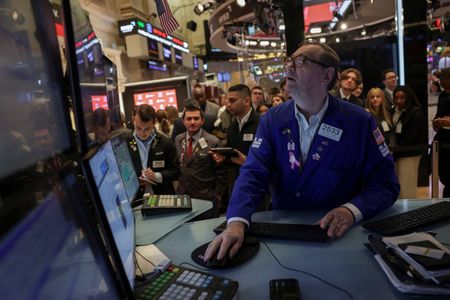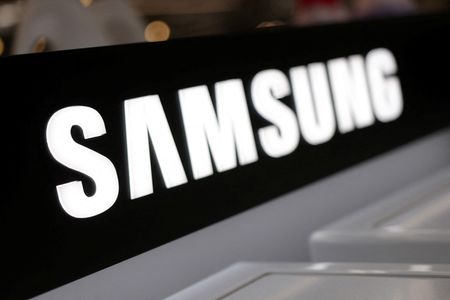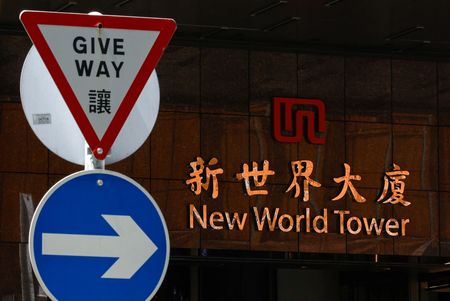By Jamie McGeever
ORLANDO, Florida (Reuters) -The tech-induced selloff across global stocks accelerated on Tuesday and soft U.S. labor market indicators also weighed on Wall Street, while fiscal worries in Japan helped drag Japanese stocks, bonds and the yen lower.
More on that below. In my column today I look at what helped trigger this swoon – a plain, old-fashioned shift in the U.S. interest rate outlook. This suggests that although many economic norms have been thrown out the window this year, some fundamentals still matter for markets.
If you have more time to read, here are a few articles I recommend to help you make sense of what happened in markets today.
1. Bubble or breakout? Nvidia earnings put AI boom underthe microscope 2. From OpenAI to Google, firms channel billions into AIinfrastructure as demand booms 3. As data flow revives, Fed still faces a deep policydivide 4. Japan warns citizens in China about safety as diplomaticcrisis deepens 5. Gilts lose their edge but not yet their attraction: MikeDolan
Today’s Key Market Moves
* STOCKS: Big three U.S. indices down 0.8-1.2%, but theRussell 2000 rises 0.6%. Japan, South Korea -3%, China -1%,benchmark European indices down 1-2%. VIX highest close sinceMay 1. * SHARES/SECTORS: Home Depot -6%, Amazon -4%, Warner BrosDiscovery +4%. Tech -1.7%, consumer discretionaries -2.5%. * FX: Dollar index flat, USD/JPY hits nine-month peak155.70, EUR/JPY record high above 180.00. Bitcoin falls below$90,000 but ends up 1.5%. * BONDS: U.S. yields down 3 bps at short end to bullsteepen the curve. Japanese yields spike – 20-year highest since1999 at 2.775%, 40-year highest on record at 3.66%. * COMMODITIES/METALS: Comex copper -0.7%, oil +1.5%, gold+1%.
Today’s Talking Points
* AI leverage, private credit concerns deepen
Concerns over the huge sums needed for Big Tech and AI capex, and worries about liquidity and transparency in private credit, are growing in tandem. The result? Deepening unease around leverage just as the Fed seems set to pause rate cuts.
Amazon is raising $15 billion in its first bond issue in three years, Boaz Weinstein’s Saba Capital Management has sold credit derivatives to lenders seeking protection on names like Oracle and Microsoft, and alternative asset manager Blue Owl – involved with Meta in the financing of a huge Louisiana data center – has moved to limit withdrawals from one of its funds.
* Technical breakdown?
For those who view technical analysis as an important part of their investment or trading tool kit, these are interesting times. Even those who dismiss it out of hand may have to respect its potential impact on markets right now.
The selloff gathering pace has pushed many asset classes and indices below key technical levels, signaling further downside ahead – the Nasdaq closed below its 50-day moving average on Monday for the first time since May, the Russell 2000 on Tuesday closed below its 100-DMA for the first time since June, and bitcoin on Friday closed below its 50-week moving average for the first time since March 2023.
* A bad day for Japanese assets
Tuesday was a bleak day for Japanese markets. The Nikkei 225 stock index lost 3%, its biggest fall since April; the yen slid to a nine-month low against the dollar and record low against the euro; long-dated JGB yields spiked to their highest on record.
The equity move is less concerning – benchmark indices are only coming off record highs. But the fiscal fear-driven bond and currency selloff is more eye-opening. At some point, they will be cheap enough to lure domestic if not foreign investors. If that doesn’t materialize soon, Tokyo might have to step in with official buying.
Wall Street wobble shows fundamentals still matter
Warnings about Wall Street’s excessive optimism, concentration risk, and frothy valuations have fallen on deaf ears for most of this year, leaving market-watchers wondering what, if anything, will cool the tech and artificial intelligence frenzy.
It turns out that it could end up being a plain old-fashioned shift in the interest rate outlook.
The S&P 500 and Nasdaq, buoyed by strong earnings and AI capex investment, have notched dozens of record highs this year, a remarkable feat given the uncertainty and poor visibility that have characterized the economic and policy landscape in 2025.
But both indices peaked on October 29, the day the Federal Reserve cut interest rates for a second consecutive meeting. Crucially, however, Chair Jerome Powell said afterwards that a third cut in December was not the “foregone conclusion” markets had seemingly thought it would be. “Far from it,” he emphasized.
In the three weeks since, the line of Fed officials expressing their reluctance to ease policy again next month has lengthened.
The resulting shift in market-based rate expectations has been dramatic.
The probability of a December rate cut fell as low as 40% on Monday, according to rates futures markets, compared with over 90% before the Fed’s October 28-29 policy meeting. The next quarter-point rate cut isn’t fully priced in until March.
Many risk assets have responded in kind.
While the benchmark S&P 500 may only be down 3% since October 29, a lot of tech and AI bellwethers have been hit harder, with the Philadelphia Semiconductor Index’s losses approaching 10%. Bitcoin, a reasonable proxy for wider risk appetite and speculative investment activity, is down 20%.
ALL EYES ON NVIDIA
There’s often no obvious trigger for market corrections or reversals, and they are typically long in the making.
For example, former Fed Chair Alan Greenspan’s famous “irrational exuberance” comment about the 1990s dotcom euphoria was in December 1996, but the bubble didn’t burst until March 2000.
There’s no suggestion that a repeat of the dotcom bust is unfolding now, but it does look like some air is coming out of today’s inflated markets. And the Fed’s hawkish steer seems to be a major catalyst, with many of the rate-sensitive AI and tech names that powered the boom earlier in the year now leading this mini swoon.
That’s in line with long-held market thinking. When firms are expected to generate strong cash flows in the future – whether they be well-established megacaps or smaller startups – a sudden swerve in the path for monetary policy can alter perceptions of their current stock valuations quite substantially.
Look no further than chipmaker Nvidia, which recently became the world’s first $5 trillion company – on October 29, no less – but has since seen its share price fall 10%.
Some of Wall Street’s largest hedge funds have recently reduced exposure to this AI leader and other U.S. megacaps. Japan’s Softbank said last week it had sold all its Nvidia shares for $5.8 billion, and tech billionaire Peter Thiel’s hedge fund also disposed of its entire Nvidia stake in the third quarter.
The AI poster child releases its latest quarterly earnings after the market close on Wednesday. With the Fed seemingly about to put rate cuts on pause, the bar for another Nvidia results-led market jump may be high.
That’s a reminder that even though many accepted market and economic rules have been thrown into doubt this year, the standard playbook hasn’t been ripped up completely.
What could move markets tomorrow?
* Japan machinery orders (September) * Indonesia interest rate decision * UK CPI and PPI inflation (October) * Euro zone inflation (October, final) * U.S. trade (August) * U.S. Treasury auctions $16 billion of 20-year bonds * U.S. earnings – Nvidia reports after market close * U.S. Fed minutes from October 28-29 meeting * U.S. Federal Reserve officials scheduled to speak includeGovernor Stephen Miran, Richmond Fed’s Thomas Barkin, New YorkFed’s John Williams
Want to receive Trading Day in your inbox every weekday morning? Sign up for my newsletter here.
Opinions expressed are those of the author. They do not reflect the views of Reuters News, which, under the Trust Principles, is committed to integrity, independence, and freedom from bias.
(By Jamie McGeever; Editing by Nia Williams)










